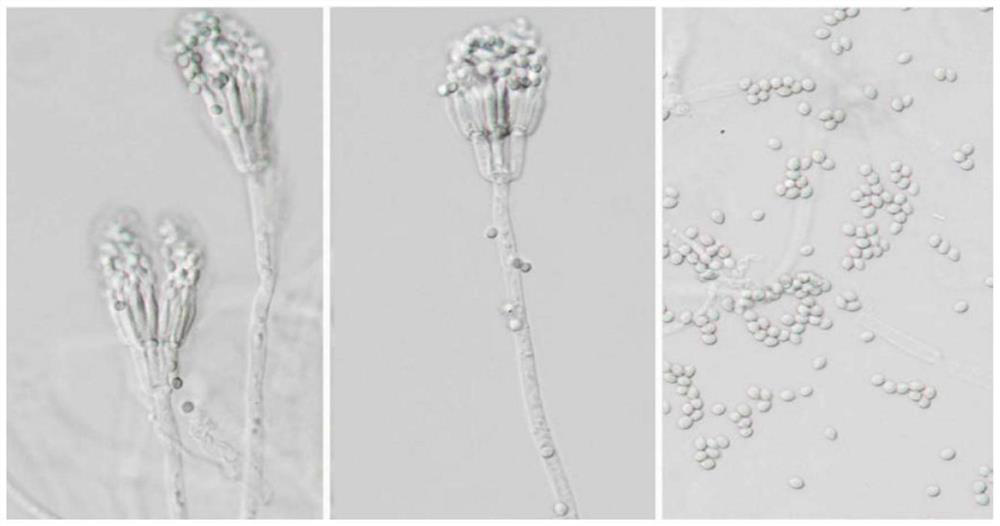an aroma-producing fungus
A technology of aroma substances and fungi, applied in the field of fungal biology, can solve problems such as the lack of microbial aroma production resources
- Summary
- Abstract
- Description
- Claims
- Application Information
AI Technical Summary
Problems solved by technology
Method used
Image
Examples
Embodiment 1
[0017] This example is the culture condition of the strain TapuXJ14C02 of the present invention
[0018] The invention proposes a fragrance-producing fungus, the fragrance-producing fungus is Talaromyces purpureogenus strain TapuXJ14C02; the culture conditions of the strain TapuXJ14C02 are: inoculate the strain TapuXJ14C02 on a PDA medium and culture it at 28 ℃ constant temperature culture; among them, the formula of PDA medium is: potato 200 g, agar powder 20 g, glucose 20 g and water 1000 mL.
Embodiment 2
[0020] This example is the morphological identification of the strain TapuXJ14C02 of the present invention
[0021] The morphological identification experiment of strain TapuXJ14C02 was as follows: strain TapuXJ14C02 was inoculated on PDA medium and cultivated at a constant temperature of 28°C. After strain TapuXJ14C02 was cultured on MEA medium for 7 days at 25°C, the colony diameter reached 9-14mm, the colony was white at the beginning, less conidia in the early stage, and a large number of spores in the later stage, which was blue-green, the aerial mycelium was more, and the back was yellowish brown. , specifically as figure 1 shown. A large number of conidia and spore-forming structures, broom-like branches are more common in bi-whorls, smooth, 150–250×2.5–3.5μm; pedicels are 3 to 5 per round, 12–14.5×2.5–4μm; phialides lanceolate Shaped, 12–13.5×2–3 μm, 3 to 6 phialides per pedicel; conidia smooth, oval, 3–3.5×2–2.5 μm, as figure 2 shown.
Embodiment 3
[0023] This example is the molecular biology identification of the strain TapuXJ14C02 of the present invention
[0024] The molecular identification experiment of described strain TapuXJ14C02 includes the following steps:
[0025] 1. Extraction of strain DNA:
[0026] 1. Genome DNA extraction: Use a kit to extract fungal DNA, and store it in a -20 ℃ refrigerator for future use;
[0027] 2. Amplification of ribosomal rDNA-ITS segment: PCR amplification was performed using fungal genomic rDNA as a template, and the primers were synthesized by Shanghai Sangon Bioengineering Co., Ltd. The amplification cycle reaction conditions were: pre-denaturation at 94 °C for 3 min; denaturation at 94 °C 30 s, annealing at 55 °C for 30 s, extension at 72 °C for 1 min, a total of 33 cycles; extension at 72 °C for 10 min; ITS-PCR amplification reaction was performed in a 50 μL reaction system (see the table below):
[0028] Primer: ITS1 5´-TCCGTAGGTGAACCTGCGG-3´
[0029] ITS4 5´-TCCTCCGCTTATT...
PUM
 Login to View More
Login to View More Abstract
Description
Claims
Application Information
 Login to View More
Login to View More - R&D
- Intellectual Property
- Life Sciences
- Materials
- Tech Scout
- Unparalleled Data Quality
- Higher Quality Content
- 60% Fewer Hallucinations
Browse by: Latest US Patents, China's latest patents, Technical Efficacy Thesaurus, Application Domain, Technology Topic, Popular Technical Reports.
© 2025 PatSnap. All rights reserved.Legal|Privacy policy|Modern Slavery Act Transparency Statement|Sitemap|About US| Contact US: help@patsnap.com



